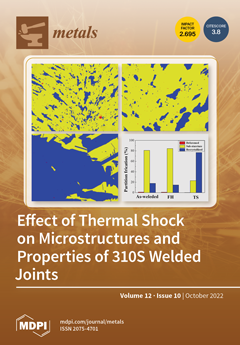Open AccessArticle
Effect of Natural Ageing on Subsequent Artificial Ageing of AA7075 Aluminum Alloy
by
Cheng-Ling Tai, Po-Jui Tai, Ting-Jung Hsiao, Po-Han Chiu, Chien-Yu Tseng, Tzu-Ching Tsao, Tsai-Fu Chung, Yo-Lun Yang, Chih-Yuan Chen, Shing-Hoa Wang and Jer-Ren Yang
Cited by 4 | Viewed by 1699
Abstract
The effects of natural ageing treatment prior to artificial ageing treatment on the microstructures and mechanical properties of AA7075 Al-5.7Zn-2.6Mg-1.5Cu-0.18Cr-0.08Mn-0.05Si-0.17Fe (wt.%) aluminum alloy have been investigated. The hardness of solution-treated samples (91.0 HV) profoundly increased to 146.8 HV after 7 days of natural
[...] Read more.
The effects of natural ageing treatment prior to artificial ageing treatment on the microstructures and mechanical properties of AA7075 Al-5.7Zn-2.6Mg-1.5Cu-0.18Cr-0.08Mn-0.05Si-0.17Fe (wt.%) aluminum alloy have been investigated. The hardness of solution-treated samples (91.0 HV) profoundly increased to 146.8 HV after 7 days of natural ageing. The purpose of the present work was to examine the kinetic hardening evolution in subsequent artificial ageing treatments of samples naturally aged for 7 days and their counterparts without natural ageing. The former were labelled as NA-7d samples, and the latter, NA-0d samples. After artificial ageing at 120 °C for 2 h, the hardness of NA-0d samples increased rapidly to 148.2 HV, which was approximately the same as that of the specimens with natural ageing for 7 days, compensating for the prior state of lower hardness without natural ageing. After being treated at 120 °C for 16 h, the ultimate tensile strength (UTS) and yield strength (YS) of NA-7d reached the highest value, respectively, 601 MPa and 539 MPa, followed by a slight decrement of UTS when aged to 24 h. On the other hand, NA-0d specimens aged at 120 °C for 16 and 24 h showed nearly the same UTS (598 MPa); the former possessed YS of 538 MPa, and the latter, 545 MPa. The results presumably reveal that the peak ageing condition for NA-0d samples can be achieved under 24 h ageing at 120 °C. Under the same treatment at 120 °C for 24 h, the size of η’ phase in NA-7d sample (with a length of 4.96 nm) coarsened and grew larger than that in NA-0d sample (with a length of 3.46 nm). In addition, some η’ phase in the NA-7d sample was found to be transformed into the η
2 phase. The results indicated that the naturally aged specimens (NA-7d) reached the peak ageing condition earlier, but did not significantly enhance the UTS in AA7075 aluminum alloy, as compared to the samples without prior natural ageing (NA-0d).
Full article
►▼
Show Figures





